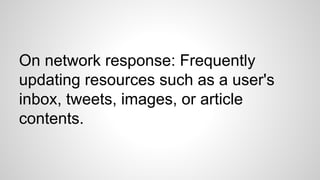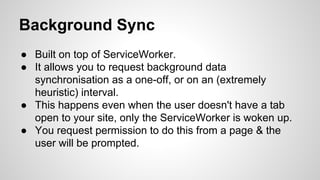Service Worker Presentation
- 2. Overview â What is a Service Worker? â What existed before the Service Worker? â Lifecycle of a Service Worker â Use cases â A fair assessment (a.k.a. the bad)
- 3. What is a service worker?
- 4. A service worker is a script that is run by your browser in the background, separate from a web page
- 5. â It's a JavaScript Worker, so it can't access the DOM directly â Service worker is a programmable network proxy, allowing you to control how network requests from your page are handled. â It will be terminated when not in use, and restarted when it's next needed â Service workers are asynchronous and make extensive use of promises â Service workers require content to be served via https
- 6. What existed before the Service Worker?
- 7. AppCache
- 9. Using the Service Worker
- 12. 1. The service worker URL is fetched and registered if ('serviceWorker' in navigator) { navigator.serviceWorker.register('/trained-to-thrill/sw.js') .then(function(reg) { console.log('success!', reg); }, function(err) { console.log('error!', err); }); }
- 13. 2. If successful, the service worker is executed in a ServiceWorkerGlobalScope; this is basically a special kind of worker context, running off the main script execution thread, with no DOM access. 3. The service worker is now ready to process events.
- 14. 4. Installation of the worker is attempted when service worker- controlled pages are accessed subsequently. An Install event is always the first one sent to a service worker 5. Same procedure as installing a native app â making everything available for use offline.
- 15. 6. When the oninstall handler completes, the service worker is considered installed. self.oninstall = function(event) { event.waitUntil( caches.open('trains-static-v14').then(function(cache) { return cache.addAll([ '/trained-to-thrill/', '/trained-to-thrill/static/css/all.css', '/trained-to-thrill/static/js/page.js', '/trained-to-thrill/static/imgs/logo.svg', '/trained-to-thrill/static/imgs/icon.png' ]); }) ); };
- 16. 7. When the service worker is installed, it then receives an activate event. The primary use of onactivate is for cleanup of resources used in previous versions of a Service Worker script. self.onactivate = function(event) { // remove caches beginning "trains-" that aren't in // expectedCaches event.waitUntil( caches.keys().then(function(cacheNames) { return Promise.all( cacheNames.map(function(cacheName) { if (!/^trains-/.test(cacheName)) { return; } if (expectedCaches.indexOf(cacheName) == -1) { return caches.delete(cacheName); }}));}));};
- 17. 8. The Service Worker will now control pages, but only those opened after the register() is successful. i.e. a document starts life with or without a Service Worker and maintains that for its lifetime. So documents will have to be reloaded to actually be controlled. this.addEventListener('fetch', function(event) { var cachedResponse = caches.match(event.request).catch (function() { return event.default().then(function(response) { return caches.get('v1').then(function(cache) { cache.put(event.request, response.clone()); return response; }); }); }).catch(function() { return caches.match('/sw-test/gallery/myLittleVader.jpg'); }); event.respondWith(cachedResponse); });
- 18. When to use?
- 19. Cache assets specific to the version of the app
- 20. Give the user a "Read later" or "Save for offline" button. When it's clicked, fetch what you need from the network & pop it in the cache.
- 21. On network response: Frequently updating resources such as a user's inbox, tweets, images, or article contents.
- 22. Push â The Push API is built on top of SerivceWorker. â Allows the ServiceWorker to be awoken in response to a message from the OS's messaging service. â Happens even when the user doesn't have a tab open to your site, only the ServiceWorker is woken up. â You request permission to do this from a page & the user will be prompted.
- 23. Background Sync â Built on top of ServiceWorker. â It allows you to request background data synchronisation as a one-off, or on an (extremely heuristic) interval. â This happens even when the user doesn't have a tab open to your site, only the ServiceWorker is woken up. â You request permission to do this from a page & the user will be prompted.
- 24. The bad news
- 26. â If installation fails, the browser is not good at telling you about it â fetch() is only available in service workers â No credentials by default (cookies) â Non-CORS fail by default (opaque response) â Handling responsive images
- 27. Demo
- 28. Questions




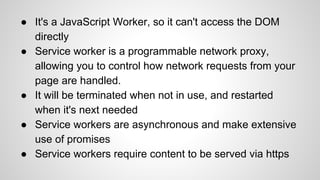


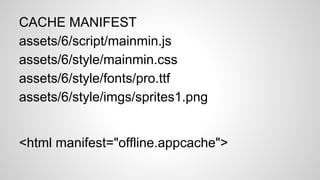

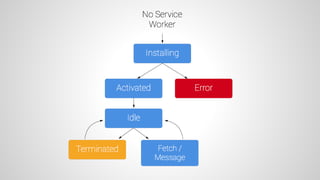
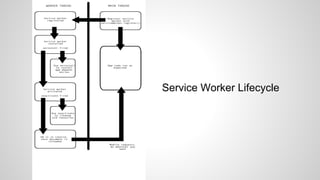
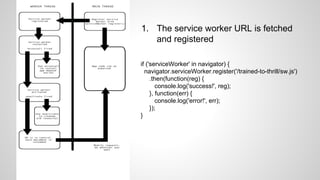
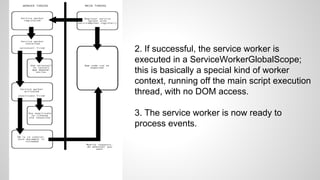
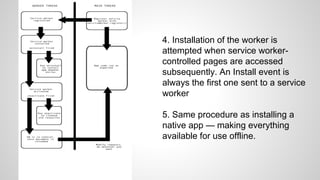
![6. When the oninstall handler completes,
the service worker is considered installed.
self.oninstall = function(event) {
event.waitUntil(
caches.open('trains-static-v14').then(function(cache) {
return cache.addAll([
'/trained-to-thrill/',
'/trained-to-thrill/static/css/all.css',
'/trained-to-thrill/static/js/page.js',
'/trained-to-thrill/static/imgs/logo.svg',
'/trained-to-thrill/static/imgs/icon.png'
]);
})
);
};](https://image.slidesharecdn.com/0c6789ea-2049-4d79-8d5d-f5843e3ef9f3-150303215506-conversion-gate01/85/Service-Worker-Presentation-15-320.jpg)





